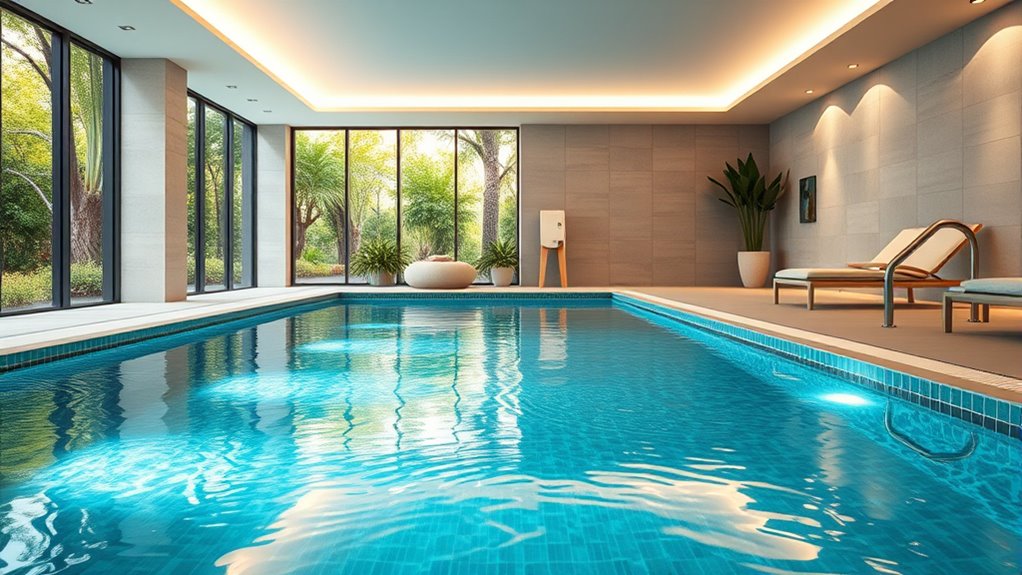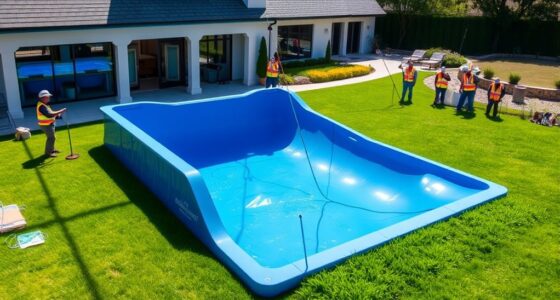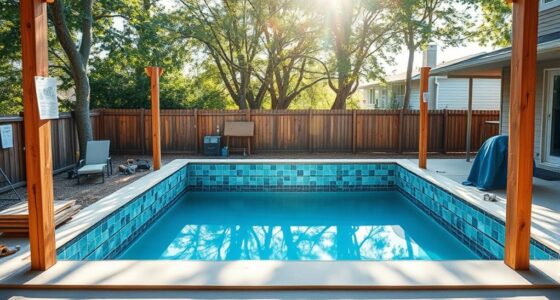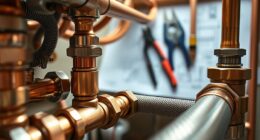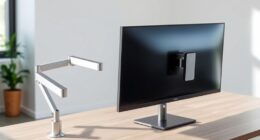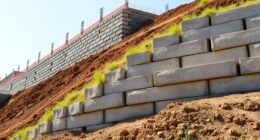To make your endless pool more energy-efficient, choose high-efficiency pumps and filters with good ratings to reduce power use. Set your water temperature between 78°F and 82°F and avoid frequent adjustments. Use insulated covers regularly to trap heat and prevent heat loss overnight. Schedule routine checks for leaks and filter cleaning, and switch to LED lighting and solar accessories for low energy consumption. Implementing these strategies can markedly lower your operating costs; explore more ways to optimize efficiency below.
Key Takeaways
- Select high Energy Star-rated pump and filter systems to ensure efficient water circulation and reduce energy consumption.
- Maintain ideal pool temperature between 78°F and 82°F, using a reliable thermometer and proper insulation to minimize heating costs.
- Use automated, insulated pool covers to retain heat, prevent heat loss, and reduce energy needed for heating.
- Regularly inspect and clean filters, calibrate controls, and check for leaks to optimize system performance and prevent energy waste.
- Switch to LED lighting, employ timers and sensors, and incorporate solar-powered accessories to lower electricity use and enhance sustainability.
Selecting a High-Efficiency Pump and Filter System
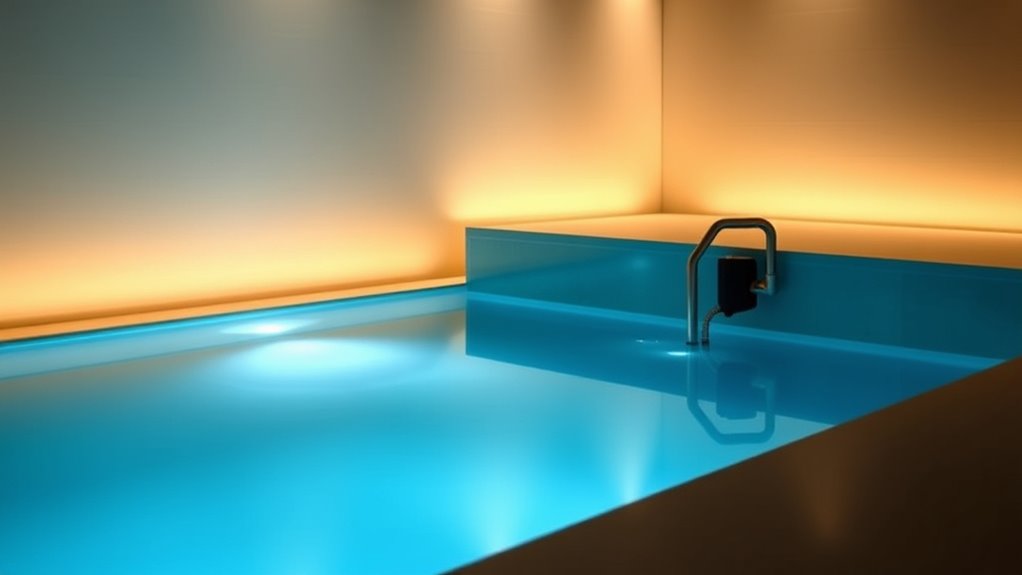
Choosing a high-efficiency pump and filter system is essential for reducing energy consumption and lowering operating costs. These systems use advanced technology to deliver powerful performance while consuming less electricity. When selecting equipment, look for models with high Energy Star ratings, as they are designed to maximize efficiency. A well-chosen pump operates smoothly, maintaining water circulation without overexerting, which saves energy. Likewise, an efficient filter system keeps water clean and clear, reducing the need for frequent maintenance and chemical use. Investing in quality, energy-efficient components may have a higher upfront cost, but it pays off over time through lower utility bills. Additionally, understanding relationships in system operation can help optimize performance and extend equipment lifespan. Remember, the right pump and filter combination ensures your pool runs efficiently, saving you money and extending equipment lifespan.
Optimizing Temperature Settings for Energy Savings

Adjusting your pool’s temperature settings can substantially cut energy costs without sacrificing comfort. Keeping your pool warmer than necessary causes your heater to work harder and use more energy. To optimize savings, set your pool temperature between 78°F and 82°F, which balances comfort and efficiency. If you rarely use your pool, consider lowering the temperature further when not in use, especially during colder months. Use a reliable thermometer to monitor and maintain your desired temperature consistently. Avoid constantly adjusting the thermostat; instead, set it once and let it stabilize. Remember, even small adjustments can lead to significant energy savings over time. Proper insulation of your pool and equipment can also help maintain temperature and reduce energy consumption insulation techniques. By managing your pool’s temperature wisely, you reduce energy consumption while still enjoying a comfortable swim whenever you desire.
Implementing Smart Pool Cover Strategies

Implementing smart pool cover strategies can considerably enhance energy savings by reducing heat loss and evaporation when the pool isn’t in use. A high-quality, insulated cover traps heat, preventing it from escaping into the air. You should use your cover consistently, especially overnight or during periods of non-use, to maximize efficiency. Automated covers can be programmed to open and close based on your schedule, ensuring the pool is covered when not in use without manual effort. Additionally, look for covers with good UV resistance and durability to maintain their insulating properties over time. Properly fitting covers eliminate gaps that can let heat escape, making your pool more energy-efficient. The effectiveness of your cover also depends on its insulating properties, which significantly influence heat retention. By adopting these strategies, you reduce heat loss, lower energy costs, and keep your pool ready for use whenever you want.
Regular Maintenance and System Checks
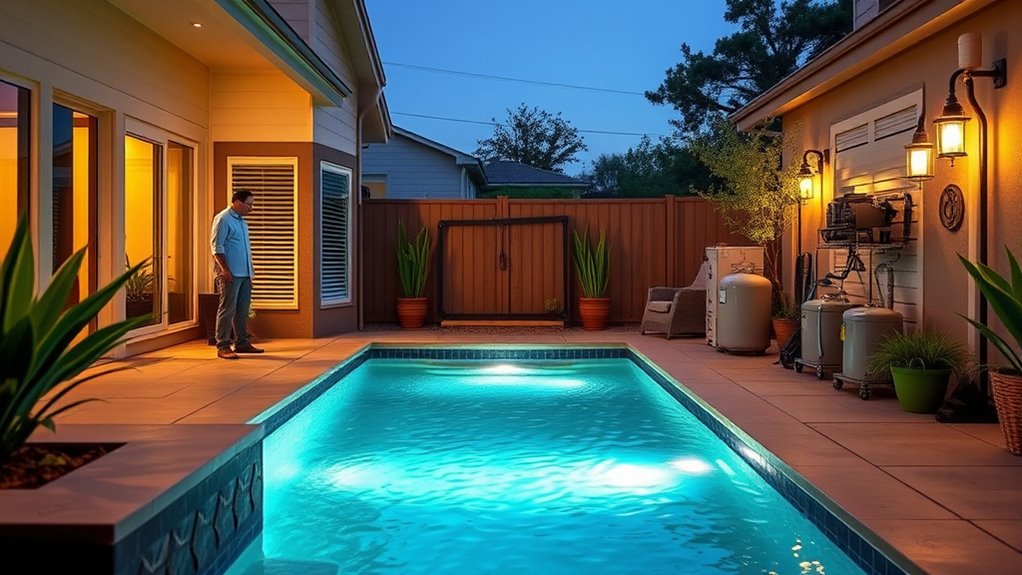
How often do you check your pool’s systems? Regular maintenance is key to keeping your Endless Pool running efficiently. You should inspect the filter, pump, and heater at least once a month to ensure they’re operating smoothly. Look for leaks, unusual noises, or signs of wear that could increase energy use. Clean the filter regularly to prevent blockages and improve water flow. Check the system controls to confirm they’re functioning correctly and calibrate them if needed. Don’t forget to verify the water temperature settings and test the system for proper operation. Routine checks help identify minor issues early, preventing costly repairs and unnecessary energy consumption. Staying proactive with system checks guarantees your pool remains energy-efficient and cost-effective to operate. Additionally, understanding the impact of AI on system optimization can help you leverage technology to monitor and improve your pool’s efficiency over time.
Incorporating Energy-Efficient Lighting and Accessories

Incorporating energy-efficient lighting and accessories can substantially reduce your pool’s operating costs while enhancing its ambiance. Switch to LED lighting, which uses less energy and lasts longer than traditional bulbs. Use timers and motion sensors to guarantee lights operate only when needed. Additionally, choose accessories like solar-powered fountains or automated covers that minimize heat loss and energy use. Proper placement of lights can create a relaxing atmosphere without increasing energy consumption. Consider the following options:
| Lighting Options | Accessories |
|---|---|
| LED Pool Lights | Solar-powered fountains |
| Timers & Sensors | Automated covers |
| Dimmer Switches | Energy-efficient pumps |
Implementing these choices helps optimize energy use, saving money while improving your pool experience. Incorporating home efficiency practices can further enhance your pool’s energy savings and sustainability.
Frequently Asked Questions
What Is the Average Annual Energy Cost for an Endless Pool?
The average annual energy cost for an endless pool typically ranges from $300 to $600, depending on usage and energy efficiency. You can lower your costs by keeping the pool well-maintained, insulating it properly, and using energy-efficient pumps and heaters. Regularly monitoring your energy consumption helps identify ways to save. By taking these steps, you guarantee your pool operates efficiently and stays affordable year-round.
How Long Does It Typically Take for Energy-Saving Upgrades to Recoup Costs?
It usually takes between 1 to 3 years for energy-saving upgrades to recoup their costs, depending on the improvements you make. If you upgrade your pool’s pump, insulation, or heater, you’ll see savings on your energy bills fairly quickly. The more efficient your upgrades, the faster you’ll recover your investment. Keep in mind, regular maintenance also helps maximize energy savings and extend the lifespan of your pool equipment.
Are There Government Rebates or Incentives for Energy-Efficient Pool Equipment?
Yes, there are government rebates and incentives available for energy-efficient pool equipment. You should check with local and federal programs, as they often offer rebates for upgrades like energy-efficient pumps, heaters, and insulation. To take advantage, you typically need to purchase qualifying equipment and follow specific application procedures. These incentives can substantially offset your costs, making upgrades more affordable and boosting your pool’s efficiency.
How Do Weather Conditions Impact Pool Energy Consumption?
Weather conditions can dramatically increase your pool’s energy use, like turning your backyard into a furnace or freezer. When it’s chilly, your heater works overtime to keep the water warm, skyrocketing energy bills. Hot, sunny days cause evaporation, prompting more filtration and chemical use. Cold or windy weather also cools your pool faster, making your pump and heater work harder. To save energy, cover your pool and adjust temperature settings based on the weather.
Can Solar Power Be Integrated to Reduce Operating Costs?
Yes, you can integrate solar power to cut your Endless Pool’s operating costs. Installing solar panels allows you to harness renewable energy to heat your pool and run the filtration system. By doing so, you reduce reliance on traditional energy sources, lower your electricity bills, and make your pool more eco-friendly. Make sure you choose the right system size and placement to maximize efficiency and savings over time.
Conclusion
By choosing smart, energy-efficient strategies, you turn your endless pool into a well-tuned symphony of savings. Think of your pool as a garden that flourishes when you give it the right care—optimized pumps, temperature, and covers are the sunlight and water. Keep up with maintenance, and watch your energy bills shrink like ice in the sun. With these tips, your pool’s efficiency shines brighter than ever, making your aquatic oasis both enjoyable and eco-friendly.
